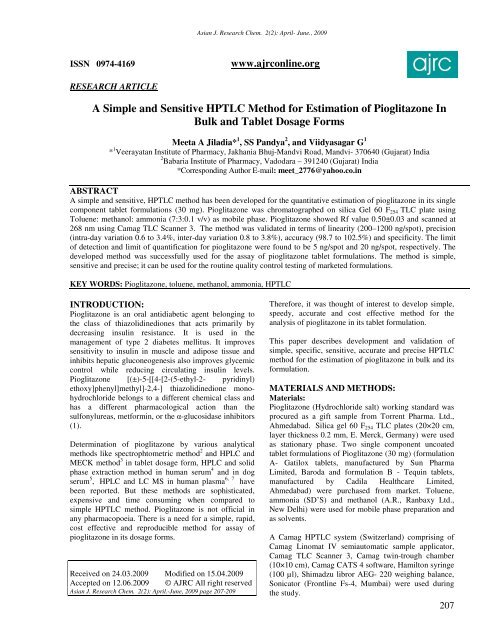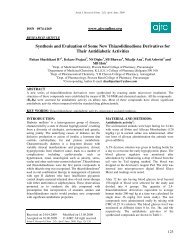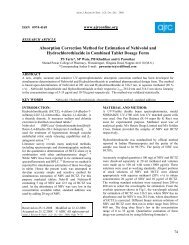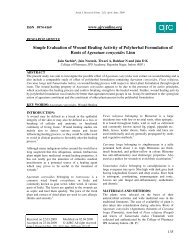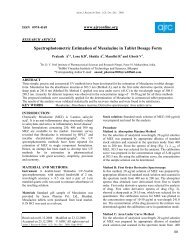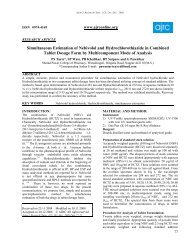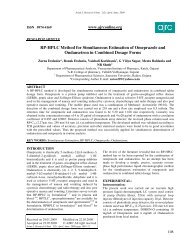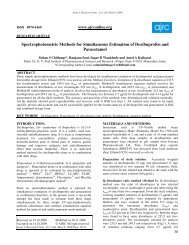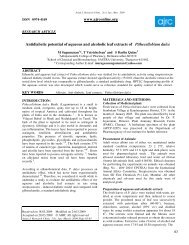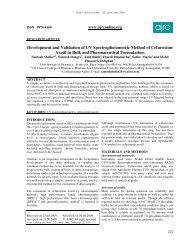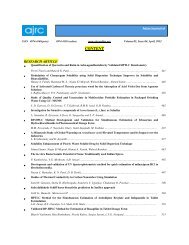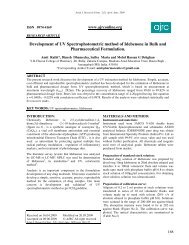A Simple and Sensitive HPTLC Method for Estimation of ...
A Simple and Sensitive HPTLC Method for Estimation of ...
A Simple and Sensitive HPTLC Method for Estimation of ...
Create successful ePaper yourself
Turn your PDF publications into a flip-book with our unique Google optimized e-Paper software.
Asian J. Research Chem. 2(2): April- June., 2009Table: 1 Summary <strong>of</strong> validation parametersN0. Parameters Result1234567Linearity range (ng/ml)Correlation co-efficientPrecisionIntra day % CV (n = 3)Inter day % CV (n =3)Repeatability <strong>of</strong> sample application (n = 7)Repeatability <strong>of</strong> peak area ( n = 7)% RecoveryLimit <strong>of</strong> detectionLimit <strong>of</strong> quantificationSpecificity200-1200 ng/spot0. 99290.6 – 3.40.8 – 3.81.30.698.7 – 102.55 ng/spot20 ng/spotSpecificPreparation <strong>of</strong> st<strong>and</strong>ard solution <strong>of</strong> pioglitazone:Pioglitazone hydrochloride (10 mg) was weighedaccurately <strong>and</strong> transferred in 10 ml volumetric flask. Itwas dissolved in <strong>and</strong> diluted up to mark with methanol.The final solution contained 1000 µg <strong>of</strong> Pioglitazone perml <strong>of</strong> the solution (S1).The solution (0.5ml) was diluted further to 10 ml withthe same solvent. The final solution contained 50 µg <strong>of</strong>pioglitazone per ml <strong>of</strong> the solution (S2).Preparation <strong>of</strong> sample solution:Ten tablets were weighed <strong>and</strong> finely powdered. Thepowder equivalent to Pioglitazone (10 mg) was weighedaccurately <strong>and</strong> mixed with methanol (5 ml) <strong>and</strong>sonicated <strong>for</strong> 10 minutes. The solution was filteredthrough Whatman NO. 41 filter paper. The residue waswashed thoroughly with methanol. The filtrate <strong>and</strong>washings were combined in a 10 ml volumetric flask <strong>and</strong>diluted to mark with methanol. The solution (0.5 ml)was further diluted to 10 ml with methanol.<strong>HPTLC</strong> method <strong>and</strong> chromatographic condition:The chromatographic estimations were per<strong>for</strong>med usingfollowing conditions; stationary phase, precoated silicagel 60 F 254 aluminum sheets (20×10 cm) (pre-washedwith methanol. <strong>and</strong> dry in air); mobile phase,Toluene:methanol:ammonia (7:3:0.1 v/v); chambersaturation time, 30 min; Temperature, 29±4 o ; migrationdistance, 45 mm; wavelength <strong>of</strong> detection, 268 nm; slitdimensions, 3×0.3 mm; scanning speed, 5 mm/s.Following spotting parameters were used - b<strong>and</strong> width,4 mm; space between two b<strong>and</strong>s, 4 mm <strong>and</strong> sprayingrate, 10 sec/µl.Chromatographic separation:Twelve µl <strong>of</strong> st<strong>and</strong>ard or sample solution wasapplied on TLC plate under nitrogen stream usingsemiautomatic spotter. The plate was dried in air<strong>and</strong> developed up to 45 mm. at constant temperatureusing mixture <strong>of</strong> Toluene : methanol : ammonia (7: 3:0.1 v/v) as mobile phase in Camag twin-troughchamber previously saturated with mobile phase <strong>for</strong>30 min. The plate was removed from the chamber <strong>and</strong>dried. Photometric measurements were per<strong>for</strong>med at268 nm in absorbance/reflectance mode with CamagTLC Scanner 3 with CATS4 s<strong>of</strong>tware incorporatingthe track optimization option.Calibration curve <strong>of</strong> st<strong>and</strong>ard pioglitazone:St<strong>and</strong>ard pioglitazone solution (4, 8, 12, 16, 20, <strong>and</strong> 24µl) was spotted on precoated TLC plate, usingsemiautomatic spotter under nitrogen stream. TheTLC plate was developed <strong>and</strong> photometricallyanalyzed as described under chromatographicseparation. The calibration curve was prepared byplotting peak area versus concentration (ng/spot)corresponding to each spot.Quantification <strong>of</strong> pioglitazone in tablet <strong>for</strong>mulation:Twenty µl <strong>of</strong> sample solution ( 50 µg/ml ) wasapplied on prewashed TLC plate, developed <strong>and</strong>scanned as described in chromatographic separation.The amount <strong>of</strong> pioglitazone present in samplesolution was determined by fitting area values <strong>for</strong>peak corresponding to pioglitazone into theequation <strong>of</strong> line representing calibration curve <strong>for</strong>pioglitazone.RESULTS AND DISCUSSION:In present work <strong>HPTLC</strong> method was developed <strong>for</strong>estimation <strong>of</strong> pioglitazone hydrochloride pure powder<strong>and</strong> its pharmaceutical <strong>for</strong>mulation. <strong>HPTLC</strong> method iscost effective <strong>and</strong> less time consuming.Pioglitazone is soluble in methanol; there<strong>for</strong>e methanolwas selected as solvent. The <strong>for</strong>mulation wasdissolved in methanol with sonication <strong>for</strong> 10 minto assure complete release <strong>of</strong> drug from the<strong>for</strong>mulation matrix.<strong>Method</strong> optimization:For optimization, different mobile phases <strong>and</strong>composition were employed to achieve the goodseparation. The method development was initiated withusing a mobile phase <strong>of</strong> n-hexane –methanol in variousproportion. In the above conditions elution was verybroad <strong>for</strong> pioglitazone. Introduction <strong>of</strong> ethyl acetate inthe above mobile phase gave sharp peaks, but poorseparation <strong>and</strong> b<strong>and</strong> broadening was observed. Earlyelution with a little separation was observed with themobile phase consisting <strong>of</strong> toluene-methanol (5:5). Inthe same mobile phase change proportion <strong>of</strong> toluene-208
methanol (7:3) gave reasonable Rf but not sharp b<strong>and</strong>.There<strong>for</strong>e need further optimization on the other h<strong>and</strong>,ammonia solution helped in sharpening <strong>of</strong> the peak.Finally, the mobile phase consisting <strong>of</strong> the mixture <strong>of</strong>toluene: methanol: ammonia (7:3:0.1 v/v) could resolvepioglitazone spot with better peak shape. Combination<strong>of</strong> toluene <strong>and</strong> methanol <strong>of</strong>fered optimum migration(Rf= 0.50±0.03) <strong>and</strong> resolution <strong>of</strong> pioglitazone fromother components <strong>of</strong> <strong>for</strong>mulation matrix. Even saturation<strong>of</strong> TLC chamber with mobile phase <strong>for</strong> 30 min assuredbetter reproducibility <strong>and</strong> better resolution. Pioglitazoneshows significant UV absorbance at wavelength 268 nm.Hence this wavelength has been chosen <strong>for</strong> detection inthe analysis <strong>of</strong> pioglitazone.The method was validated in terms <strong>of</strong> linearity, inter-day<strong>and</strong> intra-day precision, repeatability <strong>of</strong> measurement <strong>of</strong>peak area as well as repeatability <strong>of</strong> sample application,accuracy <strong>and</strong> specificity. The limit <strong>of</strong> detection <strong>and</strong> limit<strong>of</strong> quantification were also determined.A representative calibration curve <strong>of</strong> pioglitazonewas obtained by plotting the mean peak area <strong>of</strong>pioglitazone against the concentration over therange <strong>of</strong> 200 - 1200 ng/spot. A correlationcoefficient was found to be 0.9929 <strong>and</strong> RSD wasranging from 0.6- 3.4. The average linear regressionequation was represented as Y=2.5395X+1677.1, whereX=concentration <strong>of</strong> pioglitazone <strong>and</strong> Y=peak area. Thelimit <strong>of</strong> detection <strong>and</strong> limit <strong>of</strong> quantification <strong>for</strong>pioglitazone were found to be 5 ng/spot <strong>and</strong> 20 ng/spot,respectively.Inter-day <strong>and</strong> Intra-day variation range <strong>for</strong>pioglitazone was found to be 0.6 - 3.4 <strong>and</strong> 0.8 - 3.8respectively. Precision <strong>of</strong> the instrument was checked byrepeated scanning <strong>of</strong> the same spot (600 ng/spot) <strong>of</strong>seven times without changing position <strong>of</strong> the plate <strong>and</strong>% CV <strong>for</strong> measurement <strong>of</strong> peak area was found to be0.64%. Repeatability <strong>of</strong> the method was checked byspotting 12 µl <strong>of</strong> st<strong>and</strong>ard solution seven times on TLCplate (n=7) <strong>and</strong> % CV <strong>for</strong> peak area was found to be1.3%. Both the % CV, <strong>for</strong> measurement <strong>of</strong> peak area <strong>and</strong>sample applications (less than 1% <strong>and</strong> 3%, respectively),ensuring proper functioning <strong>of</strong> <strong>HPTLC</strong> system.Accuracy <strong>of</strong> method was evaluated by calculatingrecovery <strong>of</strong> drug by st<strong>and</strong>ard addition method at 5 levels<strong>of</strong> the calibration curve (n=3). The percentage recoverywas found to be 93.3 to 99.4% ensuring that the methodis accurate.The results indicate that the recovery <strong>of</strong> addedsample was between 99.6 - 102.5 %. This clearlyindicates that the method is accurate <strong>and</strong> precise.Asian J. Research Chem. 2(2): April- June., 2009three spectra indicated the purity <strong>of</strong> peak (correlation,r(S,M)=0.9999, r(M,E)=0.9993, fig. 2). The spectrum <strong>of</strong>extracted from tablet was also compared with spectrum<strong>of</strong> st<strong>and</strong>ard, which showed correlation 0.9993. It wasobserved that the excipients present in <strong>for</strong>mulationdid not interfere with the peak <strong>of</strong> pioglitazone.Different validation parameters <strong>for</strong> the proposed <strong>HPTLC</strong>method <strong>for</strong> determining pioglitazone content aresummarized in Table 1. This method was applied todetermine the content <strong>of</strong> pioglitazone in two differentmarket samples <strong>of</strong> single component pioglitazonetablets. The content <strong>and</strong> percentage <strong>of</strong> pioglitazone intwo different market samples were found to be 30.03mg, 100.1±2.9% <strong>and</strong> 29.82 mg, 99.4±1.5%, respectively(n=3). The results indicate that the proposed <strong>HPTLC</strong>method was found to be simple, specific, rapid, precise<strong>and</strong> accurate <strong>for</strong> estimation <strong>of</strong> pioglitazone in its<strong>for</strong>mulations.CONCLUSION:The results indicate that the proposed method issimple, accurate, precise <strong>and</strong> specific, <strong>for</strong>estimation <strong>of</strong> pioglitazone in bulk <strong>and</strong> its<strong>for</strong>mulations.REFERENCES:1. http:// rxlist.com/actos-drug.htm.2. Sankar,D.G., Kumar, J.M.R., Reddy, M.V.V.N.Extractive spectrophotometric determination <strong>of</strong>Pioglitazone hydrochloride using both acidic <strong>and</strong> basicdyes. Asian Journal <strong>of</strong> Chemistry. 2004; 16 (1): 251-254.3. Radhakrishna, T., Sreenivas Rao, D., Om Reddy, G.Determination <strong>of</strong> pioglitazone hydrochloride in bulk <strong>and</strong>pharmaceutical <strong>for</strong>mulations by HPLC <strong>and</strong> MEKCmethods. J. Pharm. Biomed. Anal. 2002; 29: 593.4. Zhong, W.Z., Williams, M.G. Simultaneous quantitation<strong>of</strong> pioglitazone <strong>and</strong> its metabolites in human serum byliquid chromatography <strong>and</strong> solid phase extraction. J.Pharm. Biomed. Anal. 1996; 14: 465.5. Zhong, W.Z., Lakings, D.B. Determination <strong>of</strong>pioglitazone in dog serum using solid- phase extraction<strong>and</strong> high-per<strong>for</strong>mance liquid chromatography withultraviolet (229 nm) detection. J. Chromatogr. 1989; 30;490(2): 377.6. Sripalakit, P., Neamhom, P., Saraphanchotiwitthaya, A.High-per<strong>for</strong>mance liquid chromatographic method <strong>for</strong> thedetermination <strong>of</strong> pioglitazone in human plasma usingultraviolet detection <strong>and</strong> its application to apharmacokinetic study. J. Chromatogr. B: AnalyticalTechnologies in the Biomedical <strong>and</strong> Life Sciences. 2006;843 (2): 164-169.7. Lin, Z.J., Ji, W., Desai-Krieger, D., Shum, L.Simultaneous determination <strong>of</strong> pioglitazone <strong>and</strong> its twoactive metabolites in human plasma by LC-MS/MS. J.Pharm. Biomed. Anal. 2003; 33 (1): 101-108.The method is found to be specific <strong>for</strong> pioglitazone. Thepurity <strong>of</strong> the peak was determined by comparing thespectra at three different levels i.e. at peak start(S), peakapex (M) <strong>and</strong> peak end (E). Correlation between these209


